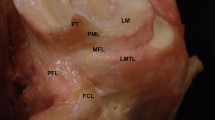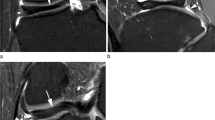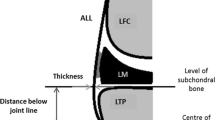Summary
Examination of the knee joint by magnetic resonance imaging (MRI) is a noninvasive technique of proven reliability as regards lesions of the menisci and ligaments [3, 4, 11]. It provides good definition of the different anatomic structures [10]. The meniscofemoral ligaments have been observed with varying frequency and may be responsible for false images [5, 16, 17]. However, it is important to detect them in cases of hypermobile discoid menisci of the ‘Wrisberg ligament type’ in order to guide the surgeon in their excision during total meniscectomy [2, 7]. We have attempted to assess the ability of MRI to visualise the meniscofemoral ligaments in correlation with an anatomic study and to identify certain anatomic pitfalls. This study will allow better investigation of the hypermobile menisci associated with the meniscofemoral ligaments. A clinical case is reported to illustrate its practical importance.
Resumé
L'exploration du genou en imagerie par résonance magnétique (IRM) est une technique non agressive qui a fait la preuve de sa fiabilité en pathologie ménisco-ligamentaire [11, 4, 3]. Elle permet d'obtenir une bonne définition des différentes structures anatomiques [10]. Les ligaments méniscofémoraux ont été observés avec une fréquence variable et peuvent être responsables d'images pièges [5, 16, 17]. Leur détection est cependant importante en cas de ménisques discoïdes hyper-mobiles, “Wrisbergligament-type”, afin de guider le chirurgien dans leur exérèse au cours de la méniscectomie totale [7, 2]. Nous nous proposons d'évaluer les capacités de l'IRM à visualiser les ligaments méniscofémoraux en correlation avec une étude anatomique, et de déterminer certains pièges anatomiques. Cette étude permettra une meilleure exploration des ménisques hypermobiles associés aux ligaments méniscofémoraux. Un cas clinique est rapporté illustrant cet intérêt pratique.
Similar content being viewed by others
References
Bellier G, Dupont JY, Larrain M, Caudron C, Carlioz H (1989) Lateral discoid menisci in children. Arthroscopy 5, No.1
Dickhaut SC, Delee JC (1982) The discoid lateral meniscus syndrome J Bone Joint Surg [Am] 64: 1068–1073
Frija G, Schouman-Claeys E, D'Anthouard F, Feron JM (1989) Grossly normal knee menisci: correlation with pathology and Magnetic Resonance Imaging. Diagn Interv Radiol 1 : 29–34
Glashow JL, Katz R, Schneider M, Scott N (1989) Double-blind assessment of the value of Magnetic Resonance Imaging in the diagnosis of anterior cruciate and meniscal lesions. J Bone Joint Surg [Am] 71: 113–119
Grover JS, Basset LW, Gross ML, Seeger LL, Finerman GAM (1990) Posterior cruciate ligament: MR imaging. Radiology 174 : 527–530
Heller L, Langman J (1964) The menisco-femoral ligaments of the human knee J Bone Joint Surg [Br] 46: 307–313
Kaplan EB (1957) Discoid lateral meniscus of the knee joint. J Bone Joint Surg [Am] 39: 77–87
Kaplan EB (1956) The lateral menisco-femoral ligaments of the knee joint. Bull Hosp Jt Dis 17: 176
Last RJ (1948) Some anatomic details of the knee joint. J Bone Jt Surg 30B: 683
Mesgarzadeh M, Schneck CD, Bonakdapour A (1988) Magnetic Resonance Imaging of the knee and correlation with normal anatomy. Radiographics 8: 707–733
Mink JH, Levy T, Crues III JV (1988) Tears of the anterior cruciate ligament and menisci of knee: MR imaging evaluation. Radiology 167 : 769–777
Poirier P, Charpy A (1892–1904) Traité d'Anatomie Humaine. Paris, Masson
Silverman JM, Mink JH, Deutsch MD (1989) Discoid menisci of the knee: MR imaging appearance. Radiology 173 : 351–354
Smillie IS (1948) The congenital discoid meniscus. J Bone Joint Surg [Br] 30: 671–681
Vahey TN, Bernett HT, Arrington LE, Shelbourne KD (1990) MR imaging of the knee: pseudo-tear of the lateral meniscus caused by menisco-femoral ligament. Am J Radiol 154 : 1237–1239
Watanabe AT, Carter BC, Teitelbaum GP, Bradley WG (1989) Common pitfalls in Magnetic Resonance Imaging of the knee. J Bone Joint Surg [Am] 71: 857–861
Watanabe AT, Carter BC, Teitelbaum GP, Seeger LL, Bradley WG (1989) Normal variation in MR imaging of the knee appearance and frequency. Amer J Radiol 153: 341–344
Watanabe M, Takeda S, Kieuchi H (1979) Atlas of Arthroscopy, 3rd edn. Tokyo, Igakushoin
Author information
Authors and Affiliations
Rights and permissions
About this article
Cite this article
Hassine, D., Feron, J., Henry-Feugeas, M. et al. The meniscofemoral ligaments: magnetic resonance imaging and anatomic correlations. Surg Radiol Anat 14, 59–63 (1992). https://doi.org/10.1007/BF01628044
Received:
Accepted:
Issue Date:
DOI: https://doi.org/10.1007/BF01628044




